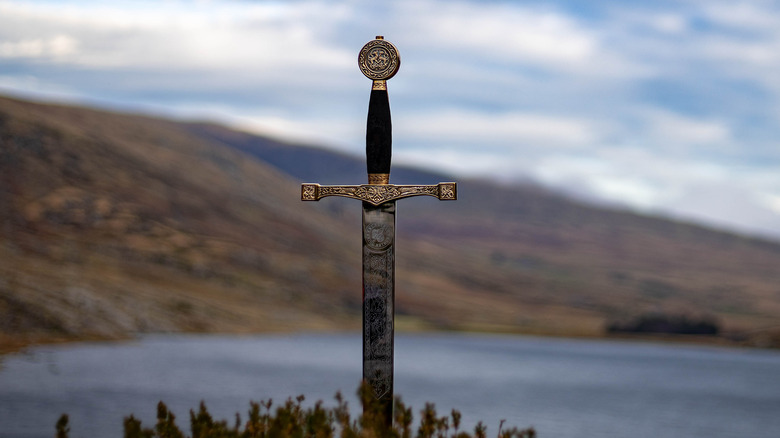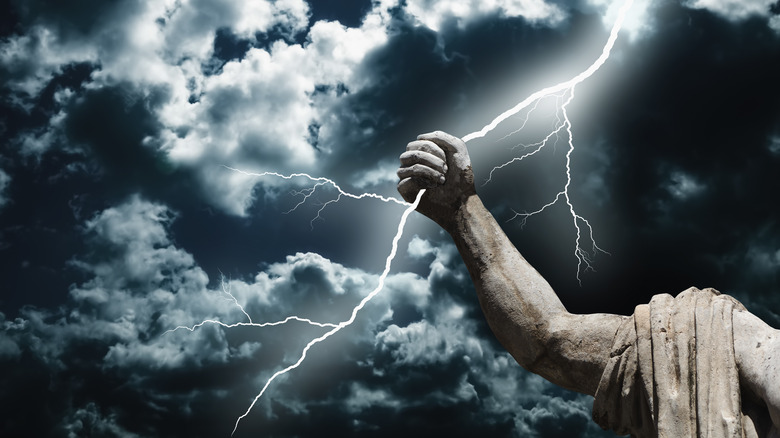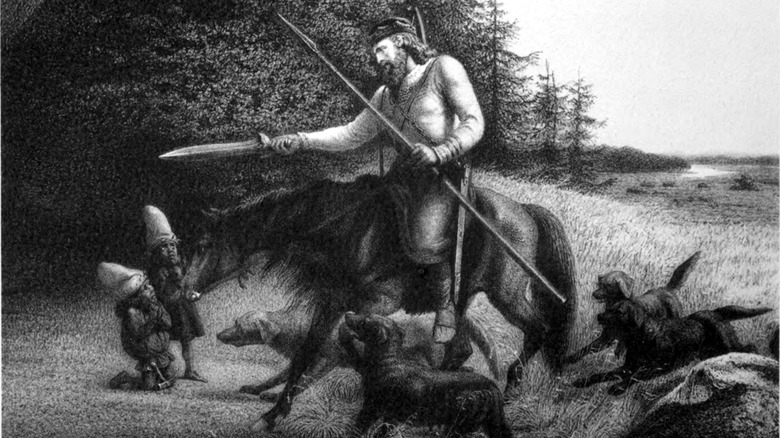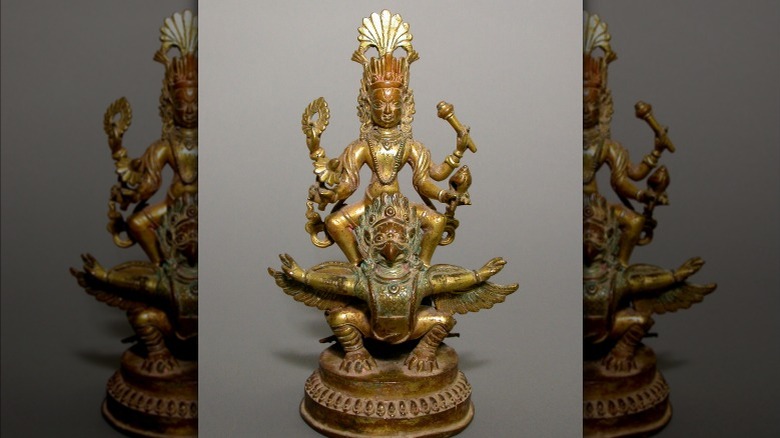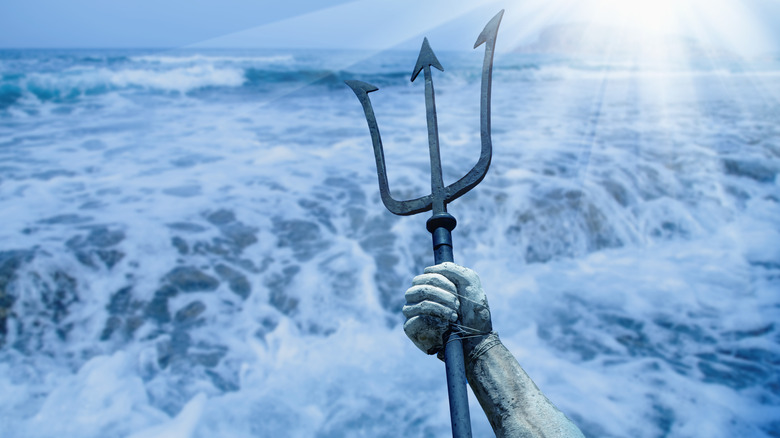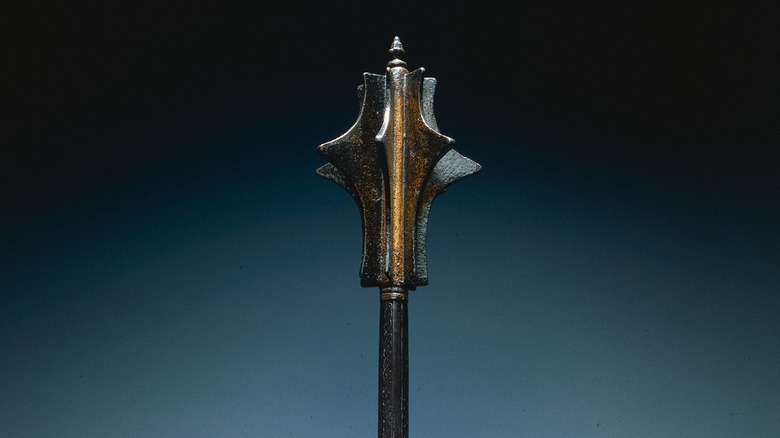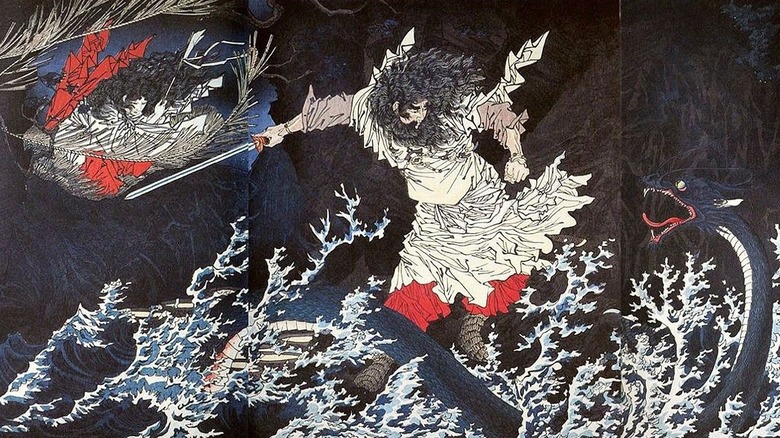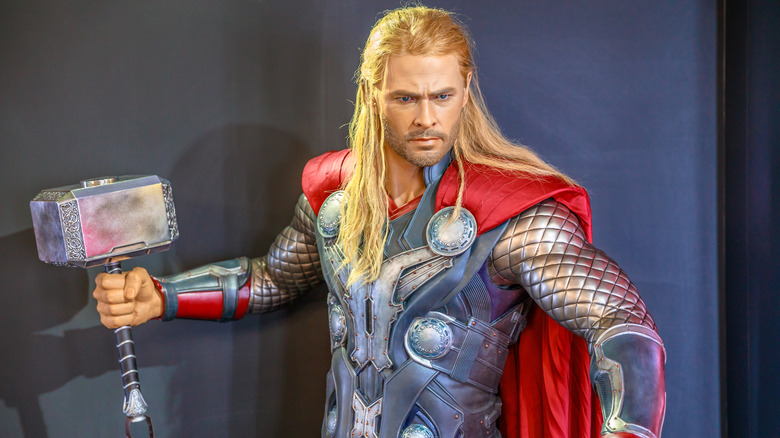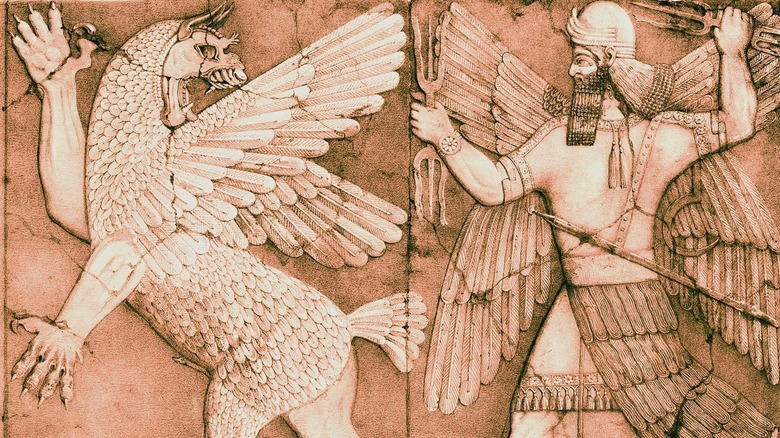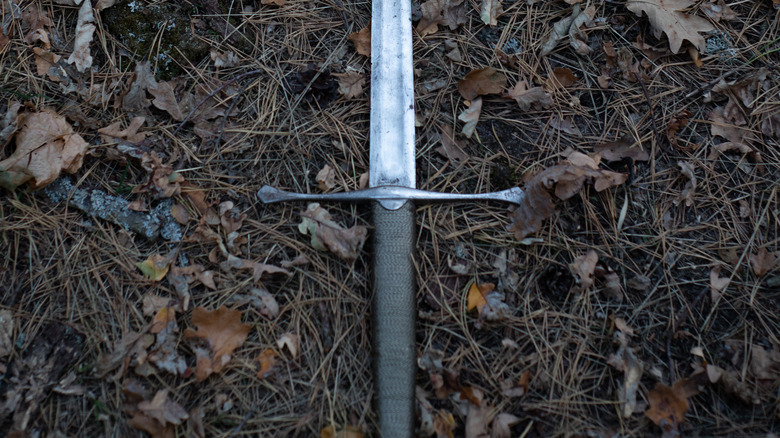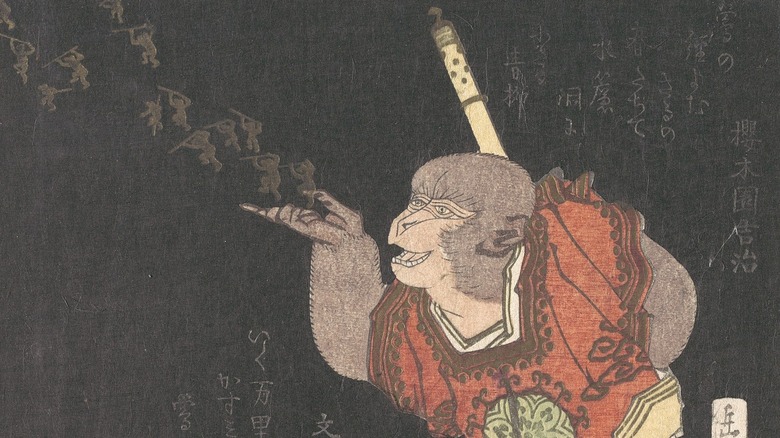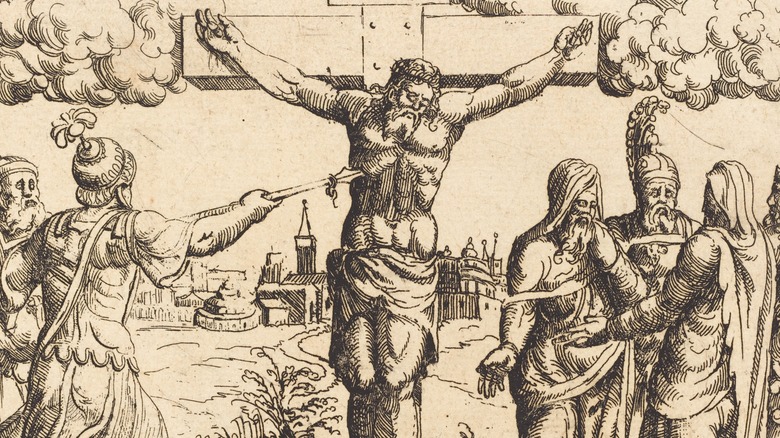Most Dangerous Weapons In Mythology
As any roleplaying gamer knows, getting a named weapon is a very cool thing. For example, in the Legend of Zelda series, why have a plain rusty sword when you can have the uniqueness and power of the Master Sword? Perhaps this is why mythological weapons are plainly fascinating. Who wouldn't want to use a hammer that casts lightning, or even better, wields lightning itself?
Mythological weapons are all dangerous, but some are more dangerous than others. Some are dangerous for their raw power, others because of their symbolism, and still some by what they purportedly can do to their wielders. This selection of mythology's most dangerous weapons looks at various traditions around the world to compare how they were not just potent tools for destruction but also important symbols for the cultures and civilizations they represented. Of course, most of these weapons are pure legend, but there are some that purportedly still exist. So let's get off to a bang with Zeus' thunderbolt.
Zeus' thunderbolt
Zeus is the most powerful of the Olympian gods of Greece. But he wasn't always the top deity. To get there, Zeus needed to lead a rebellion of upstart gods against the previous generation of deities called the Titans. This group included his own father, Chronos, who incidentally cannibalized Zeus' siblings in fear that one of them would overthrow him. Fortunately for Zeus, he was hidden by his mother Rhea and able to start the insurrection. After managing to get Chronos to upchuck his siblings, Zeus opened the hells of Tartarus to unleash all sorts of creatures that helped to overthrow the Titans. According to the Theoi Project, this included the one-eyed giants known as the Cyclopes. These creatures forged three magical items for Zeus and his two brothers: a trident for Poseidon, a helmet for Hades, and a thunderbolt for Zeus. And these weapons were used to good effect against the Titans.
The thunderbolt, as related by "Zeus as (Rider of) Thunderbolt," reflects Zeus' personification of storm and sky. In an instant, the sky god could smite an individual dead from afar. It also related how he could ride the lightning instantly and descend from the heavens. While not exactly the most subtle of weapons, Zeus' thunderbolt is undoubtedly one of the most powerfully dangerous in mythology.
The sword Tyrfing
Norse mythology features many fearsome weapons, and one of the most dangerous was the sword Tyrfing. According to "Mythological Swords," Tyrfing — sometimes spelled Tirfing or Tyrving — was created when King Svafrlami, the grandson of the god Odin, trapped the dwarves Dulin and Dvalin and forced them to make him a sword.
The dwarves were master smiths and resentfully forged Tyrfing. The sword never rusted, featured a golden hilt, and could cut rocks and iron like butter. To make it even more intimidating, it glowed like fire. But the dwarves decided to take revenge by laying curses on the sword. First, every time the sword was drawn, it was destined to kill. Second, the sword was to be the cause of three great evils. And third, the sword would kill Svafrlami. When Svafrlami found this out, he tried to kill the dwarves, but even though Tyrfing penetrated deep into the rock, they escaped.
Tyrfing's third curse came to pass when Svalfrlami was killed by the berserker Arngrim. What follows is a bloodbath as the sword goes about performing its three evil deeds. First, it slays the Swedish hero Hjalmar. Second, it causes an heir of the sword, Heidrek, to kill his brother. In the end, the curse is broken when Heidrek is killed by the sword at the hands of his own thralls. This was the third evil deed of the sword before Heidrek's son took vengeance and claimed Tyrfing, now uncursed, as his own.
Vishnu's Sudarshana Chakra
Vishnu is one of the most important deities in Hinduism's pantheon. As described by the World History Encyclopedia, Vishnu is known as the "Preserver." He is a guardian of men who appears on Earth in the form of various avatars to fight demons and preserve stability in the cosmos. And of course, to fight demons, you need a weapon, and Vishnu's is one of the most vicious out there.
Called the Sudarshana Chakra (sometimes spelled Sudarsanacakra), this weapon is a discus composed of 108 blades. This design is symbolic of Vishnu's association with the sun and also a representation of the Hindu depiction of the Wheel of Life. As explained by "Hidden Religion," Vishnu's weapon may have been inspired by or been the inspiration for real chakram spinning disc weapons. As for the mythology behind it, "Signboard at Dholavira" says the Sudarshana Chakra was created by Vishwakarma the "architect of the Gods from the dust of the sun and from the scraps that fell from Shiva's trident." The weapon can destroy anything and traditionally cannot be used by mortals. However, it was used by the hero Arjuna, who was given it by Krishna — an incarnation of Vishnu.
Poseidon's trident
If you were the god of the sea, what types of powers would you imbue into your weapon? How about the ability to generate earthquakes? This is one of the main features of the Greek god Poseidon's famous three-pronged trident.
According to the Theoi Project, Poseidon — Neptune in the Roman tradition — had a trident that was forged by the Cyclopes at the same time as Zeus' thunderbolt and Hades' helmet. Poseidon's trident probably originated from a simple fishing spear, Britannica reports. But this fishing spear could also create an earthquake, shatter rocks, and calm a stormy sea. It is for this reason that Poseidon is also the god of earthquakes. In fact, according to "Poseidon, Walls, and Narrative Complexity in the Homeric Iliad," this earth-shaking power was Poseidon's greatest. Even his association with horses is tied to earthquakes being linked to the sound and feel of the thundering of many hooves. And the trident is associated with the iconography of this particular god more than any other. Indeed, if you see an image of somebody holding a trident, you are likely to think of Poseidon.
Sharur the Speaking Mace
Before there was artificial intelligence, there was Sharur. The World History Encyclopedia explains that Sharur was the massive mace of Ninurta, the hero-god of hunting and war in ancient Sumeria. As "The Monster Hunter's Handbook" explains, the weapon's name meant "smasher of thousands." However, Sharur was more like a boon companion than just a big billy club. Unique among mythological weapons, Sharur had sentience, logic, and reason.
The most notable use of Sharur was when Ninurta fought the demon Asag (also called Agag), who was a demon of sickness and disease. As described by "Philosophy, Religious Studies, and Myth," Sharur then worked as a Star Trek tricorder providing crucial information on the monster. When Ninurta started to lose his confidence, Sharur gave the god a pep talk worthy of a motivational speaker. What is more, when Ninurta couldn't slay Asag outright, the mace flew back to Ninurta's father to come up with a new strategy. Ultimately, the plan settled on softening the demon up by rainstorms so Ninurta and Sharur could give the monster the coup de grâce.
Japan's Kusanagi
Traditional Japanese feudal society is associated with the valor and chivalry of its warrior class, the samurai. And if there is one possession the samurai prized above all others, it was the sword. There are lots of swords and weapons in Japanese mythology, but the greatest one of all is a real thing: the sword called Kusanagi.
Britannica relates how according to Japanese myth, the Kusanagi sword was first found in the tail of an eight-headed dragon by the storm god Susanoo. The god then gave it to his sister, the sun goddess Amaterasu, who then gifted it to her grandson, Ninigi, who came to Earth to become the ruler of Japan. The sword has been passed down through the years and is one of the three sacred treasures of Japanese imperial regalia. However, the sword remains hidden along with the other regalia, so no person has ever seen it.
Kusanagi is supposed to have divine powers. One example of this is when the hero Yamato Takeru used the sword to cut back the burning grass that Ainu tribesmen set ablaze around him. "Tokyo Cyberpunk" also describes how Yamato was able to direct the power of the wind to set fire on his enemies. Fittingly, the name of the sword means "grass mower." More importantly, the sword is a symbol of national identity; Kusanagi is thus comparable to Excalibur in Britain.
King Arthur's Excalibur
Any list of mythological weapons must have Excalibur. This was the legendary sword of King Arthur of Britain, and it was also was called Caliburn, according to "Mythological Swords." Excalibur's history is somewhat blurred since sources sometimes treat it as the Sword in the Stone, and other times it is a separate weapon given to Arthur by the Lady of the Lake. But in both cases, the king was guided by the wizard Merlin, the World History Encyclopedia reports.
The sword signified the right of Arthur to rule, but unlike Kusanagi, it was only held by Arthur during his reign before returning to the Lady of the Lake. Whatever the case, Excalibur's origins are unearthly, with some traditions holding that it was forged on the mystical isle of Avallon. The sword has also been attributed with some powers — it purportedly burned so brightly that it blinded enemies. And in the right hands, it was said the be powerful enough to slay heaps of foes. But that's not all! Excalibur's scabbard also allowed the wearer to suffer blood loss and not die, and some tales say that wounds did not bleed at all when wearing the scabbard. So, as a whole, the scabbard seems to be more magically powerful than the blade. Nevertheless, Excalibur's power rests in its symbolism over the right to rule.
Thor's Mjolnir
As anybody who is familiar with Marvel Comics knows, the superhero Thor wields a mystical hammer. While this popular take is not always the most accurate rendering of the Norse god of thunder, it has the benefit of making Thor's weapon, Mjolnir, a household name.
As explained by the "Encyclopedia of Mythological Objects," the meaning of Mjolner's name — "Pulverizer," or "That Which Smashes" — is rather straightforward. It was originally created by two dwarf-brothers, Brokkr and Eitri, as part of a wager made between them and the god of mischief, Loki. However, to win the bet, Loki cheated by biting the dwarves as they wrought the hammer. As noted in "Goddess," the result was a handle that was too short. However, Thor was pleased with it for its marvelous abilities and used it to slay giants of the realm of Jotunheim.
Mjolnir had several special attributes. For example, it could be folded up and stuffed into a small area, which is why Thor usually kept Mjolnir tucked in his shirt. Even more impressive, the hammer never missed its target. And when thrown, the hammer always returned to its owner. Mjolnir was also red-hot to the touch and befitting the god of thunder, it shot lightning. Given its short shaft with these properties, Thor wore special gloves called the Jarngreipr that allowed him to handle this divine and dangerous weapon.
Marduk's Imhullu
The most important deity to the ancient city of Babylon was its patron god, Marduk. According to the World History Encyclopedia, Marduk had a very eclectic divine resume — he was responsible for justice, healing, and compassion and was also a storm and agricultural god. Indeed, Marduk defeated Tiamat, the incarnation of chaos, to bring order to the universe and create heaven and earth and co-create humanity.
It is in his battle with Tiamat that Marduk uses a weapon named Imhullu, which means "evil wind," per "Bel and the Dragon." The weapon is not like any other since its power comes from the use of the elements themselves. Using a net gifted to him by his father Anu, Marduk trapped Tiamat. And then, when the monster opened her mouth to devour him, the Imhullu flowed in, forcing it open. Tiamat's belly distended from another wind that Marduk sent upon her, and the god shot an arrow into it, killing her.
Fragarach, the Answerer
In Irish mythology, the sea god and guardian of the underworld, Manannan mac Lir, wielded the divinely-created sword Fragarach. "Mythological Swords" identifies several characteristics of Fragarach that differentiate it from other swords of power that pop up in mythologies around the world. Aside from being able to cut through shields and walls, the blade delivered a piercing wound that could not be healed. Thus, Fragarach was dangerous even to the wielder if they didn't know what they were doing. Second, when the sword was placed to a person's throat, they could neither move nor tell lies. Sort of like Wonder Woman's lasso but a bit more forceful. It is for this reason that the sword is also called the "Answerer." Its other name was the "Retaliator." Another trait of the sword identified by the "Encyclopedia of Mythological Objects" was that he who wielded Fragarach controlled the wind itself.
Mannan Mac Lir passed Fragarach onto his foster son Lugh before it came into the hands of the famous Irish hero Cuchulain. In turn, Cuchulain passed the weapon onto Conn of the Hundred Battles, where it slipped out of lore.
The Monkey King's Ruyi Jingu Bang
One of the great stories of traditional China is the Ming Dynasty novel "The Journey to the West." According to the Association of Asian Studies, the work is based on the pilgrimage of the monk Xuanzang to India in A.D. 7. Xuanzang is accompanied by various companions, including a monkey, Sun Wukong, also known as the Handsome Monkey King. He was kicked out of the Celestial court for misbehavior, and Xuanzang and Monkey have numerous adventures fighting brigands and monsters while experiencing moments of Buddhist enlightenment.
As explained by "Beneath the Moon," the Monkey King used the Ruyi Jingu Bang to battle his enemies. This was a magical golden staff that he earned after defeating the dragons of the four seas. "A Brief History of the Immortals of Non-Hindu Civilizations" states that the staff had the ability to change size or fight independently from its user. For example, when the Monkey King originally found it, it was over 8 tonnes, but when it was stowed behind his ear, it was the size of a needle. According to "The Shaolin Monastery," its normal size was 20 feet. Using this weapon, the Monkey King was able to defeat an army of 100,000 celestials, which is basically 100,000 boss fights. The English translation of the weapon's name is "As You Wish Golden Rings Clasped Staff," which reflects its ability to do exactly what the wielder wished.
The Spear of Destiny
One of the holiest and most legendary relics in the Christian tradition is the Spear of Longinus, also known as the Holy Lance or the Spear of Destiny. As described by Britannica, when Jesus Christ was hung on the cross, a Roman soldier who has been identified as Longinus pierced Jesus' side with a spear. Since then, this spear or lance has long been considered a powerful artifact with immense powers on par with the Holy Grail.
One well-known example of the use of the lance was during the First Crusade. According to the story, peasant Peter Bartholomew had a vision from St. Andrew telling him to retrieve the lance to use it against Islamic forces. After reporting his vision to Crusade leaders, a search was conducted. Nothing was found until Bartholomew jumped into a pit and pulled out a long iron rod, claiming it was indeed the Holy Lance. It was accepted, and the Crusaders used it to successfully take the ancient Greek city of Antioch. Later, Bartholomew was put to an ordeal by fire to see if he was really telling the truth and died in the process, discrediting him in Christendom.
There are currently three different relics that claim to be the authentic Holy Lance, although none of them seem to emit holy powers.
